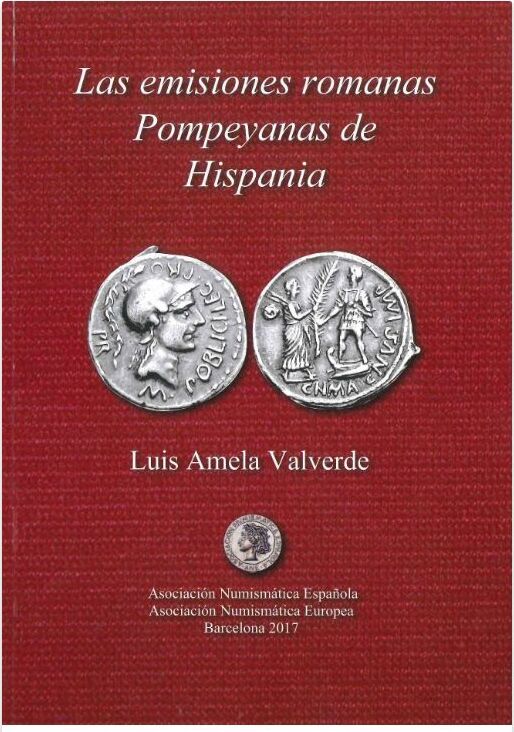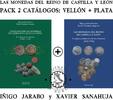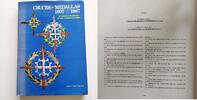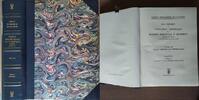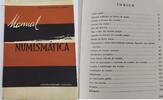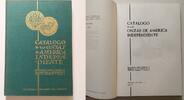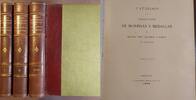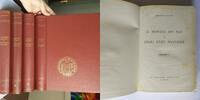MA-ID: 120602242
Bewertungen La Dobla
Perfect! Thank you!
Item well packed and shipped.
Good communication.
Item received in good order, well packaged and shipped quickly. A great add...
Item received in good order, well packaged and shipped quickly.
I'm very ...
SPAIN LAS EMISIONES ROMANAS POMPEYANAS DE HISPANIA 2017 Luis Amela
Numismática La Dobla 

5
Seit 5 Jahren bei MA-Shops
767 Bewertungen,
100 % Positiv (seit 24 Monaten)
Weltweiter Versand
25,95 EUR
Differenzbesteuert nach §25a UStG
zzgl. 8,00 EUR Versand ( nach Deutschland )
Lieferzeit: 4 - 7 Tage*
zzgl. 8,00 EUR Versand ( nach Deutschland )
| Bestellhotline +49 (0)2871 2180 383 |
| Zahlungsarten |
| Überweisung |
Papier
2017 – Pompeian Roman emissions from Hispania – Luis Amela
(Review by David Martínez Chico in numismatic magazine HECATE)
The author of the book, known in the Spanish numismatic world for his numerous works about Pompey the Great, his family and his series Varia nummorum (of which he has just published its seventh volume), presents us with the fruit of his more than twenty-five years of research on the theme that gives title to the work. Extensively illustrated, he presents photographs of all the coins he discusses in the text, as well as an extensive bibliography. The volume is articulated in a prologue, by J. Pellicer Bru, president of ANE, introduction, five chapters, conclusions and bibliography.
In the first chapter, “The RRC emissions 446 and 447 in the name of Pompey the Great” (pp. 17-41), the series made by Varro and Piso are analyzed. Extensive discussion about where these coins were made (including Hispania, the reason for their inclusion), to conclude that they were made on the Illyrian coast during the year 48 BC. The curious variant RRC 447/1b seems to indicate that Caesar's landing in the Balkans caught Pompey off guard. Likewise, several imitations of this numerary are included, highlighting the one that seems to be made in the Balkans in the name of Varro.
In the second chapter, “The RRC 469 emission of Gnaeus Pompey Jr.” (pp. 43–60), the author concludes that it was made in the city of Carthago Nova during the year 47 BC, coinciding with a civic bronze series of this city, in which Sabinus, the moneymaker of Roman coinage, is mentioned. He eliminates the Crawford variants from this series, which he considers to be coinages, and classifies them according to the obverse legend.
The obverse does not represent Rome but Mars. Interesting discussion on the use of the term imperator. In the third chapter, “The issuance RRC 470 of Gnaeus Pompey Jr.” (pp. 61–85), it is considered that this coinage was carried out in the city of Corduba in the year 46 BC. Discussion about the purpose of the monetary production of Gnaeus Pompey Jr. in Hispania. In the fourth chapter, “The RRC 477 broadcast of Sextus Pompey” (p. 87-121), after a long debate, he reaches the conclusion that it must have been broadcast in the year 44 BC. in the peninsular noon after the defeat of the Caesarian governor C. Asinio Polión, without being able to determine the mint(s) responsible for the production. Extensive treatment of Pietas, who will eventually give the nickname to Sextus Pompey, who appears on the reverse of this coinage.
In the fifth and final chapter, perhaps the most interesting, “The bronze coins RRC 471, 478 and 479” (pp. 123-152), the bronze coins in the name of Pompey's children are studied. The first, RRC 471, by Gnaeus Pompey Jr., would have been carried out in Corduba in the year 46 BC. with the same traditional iconography of republican slabs, resumption of issuance of official fractional coins after the closure of the Rome workshop ordered by C. Cornelius Sulla after the civil war (81 BC).
The other two, RRC 478 and 479, by Sextus Pompey, although they have been attributed to Hispania, in reality the first was carried out in the city of Massalia during the year 44/43 BC. or failing that on the island of Sicily during the period 43-36 BC; The second is a Sicilian coinage of the last date mentioned above. At an iconographic level, it should be noted that in the RRC 479 issue the figure of Pompey appears as the god Janus, in tradition with the representation of Pompey himself by his son Sextus Pompey in RRC 483 as the god of the sea, Neptune. Likewise, note the correction of the legend in RRC 478, which does not include the affiliation of the monetary, but rather the word imperator.
The conclusions, logically, are the summary of what is discussed in the work. In short, we are faced with a serious and correct work of this coinage, which corrects the classic work Roman Republican Coinage by Crawford, while following in the wake of Arma et Nummi by Woytek. In this way, the silver issues RRC 446 and 447 of Varrón y Pisón and the bronze series RRC 478 and 479, of Sextus Pompeyo, disappear from the peninsular area, thus maintaining the issues RRC 469, 470 and 471 of Gnaeus in Hispania. Pompey Jr., and RRC 477 of Sextus Pompey.
(Review by David Martínez Chico in numismatic magazine HECATE)
The author of the book, known in the Spanish numismatic world for his numerous works about Pompey the Great, his family and his series Varia nummorum (of which he has just published its seventh volume), presents us with the fruit of his more than twenty-five years of research on the theme that gives title to the work. Extensively illustrated, he presents photographs of all the coins he discusses in the text, as well as an extensive bibliography. The volume is articulated in a prologue, by J. Pellicer Bru, president of ANE, introduction, five chapters, conclusions and bibliography.
In the first chapter, “The RRC emissions 446 and 447 in the name of Pompey the Great” (pp. 17-41), the series made by Varro and Piso are analyzed. Extensive discussion about where these coins were made (including Hispania, the reason for their inclusion), to conclude that they were made on the Illyrian coast during the year 48 BC. The curious variant RRC 447/1b seems to indicate that Caesar's landing in the Balkans caught Pompey off guard. Likewise, several imitations of this numerary are included, highlighting the one that seems to be made in the Balkans in the name of Varro.
In the second chapter, “The RRC 469 emission of Gnaeus Pompey Jr.” (pp. 43–60), the author concludes that it was made in the city of Carthago Nova during the year 47 BC, coinciding with a civic bronze series of this city, in which Sabinus, the moneymaker of Roman coinage, is mentioned. He eliminates the Crawford variants from this series, which he considers to be coinages, and classifies them according to the obverse legend.
The obverse does not represent Rome but Mars. Interesting discussion on the use of the term imperator. In the third chapter, “The issuance RRC 470 of Gnaeus Pompey Jr.” (pp. 61–85), it is considered that this coinage was carried out in the city of Corduba in the year 46 BC. Discussion about the purpose of the monetary production of Gnaeus Pompey Jr. in Hispania. In the fourth chapter, “The RRC 477 broadcast of Sextus Pompey” (p. 87-121), after a long debate, he reaches the conclusion that it must have been broadcast in the year 44 BC. in the peninsular noon after the defeat of the Caesarian governor C. Asinio Polión, without being able to determine the mint(s) responsible for the production. Extensive treatment of Pietas, who will eventually give the nickname to Sextus Pompey, who appears on the reverse of this coinage.
In the fifth and final chapter, perhaps the most interesting, “The bronze coins RRC 471, 478 and 479” (pp. 123-152), the bronze coins in the name of Pompey's children are studied. The first, RRC 471, by Gnaeus Pompey Jr., would have been carried out in Corduba in the year 46 BC. with the same traditional iconography of republican slabs, resumption of issuance of official fractional coins after the closure of the Rome workshop ordered by C. Cornelius Sulla after the civil war (81 BC).
The other two, RRC 478 and 479, by Sextus Pompey, although they have been attributed to Hispania, in reality the first was carried out in the city of Massalia during the year 44/43 BC. or failing that on the island of Sicily during the period 43-36 BC; The second is a Sicilian coinage of the last date mentioned above. At an iconographic level, it should be noted that in the RRC 479 issue the figure of Pompey appears as the god Janus, in tradition with the representation of Pompey himself by his son Sextus Pompey in RRC 483 as the god of the sea, Neptune. Likewise, note the correction of the legend in RRC 478, which does not include the affiliation of the monetary, but rather the word imperator.
The conclusions, logically, are the summary of what is discussed in the work. In short, we are faced with a serious and correct work of this coinage, which corrects the classic work Roman Republican Coinage by Crawford, while following in the wake of Arma et Nummi by Woytek. In this way, the silver issues RRC 446 and 447 of Varrón y Pisón and the bronze series RRC 478 and 479, of Sextus Pompeyo, disappear from the peninsular area, thus maintaining the issues RRC 469, 470 and 471 of Gnaeus in Hispania. Pompey Jr., and RRC 477 of Sextus Pompey.
Info / FAQ
| Versandkosten | ||||
|---|---|---|---|---|
| bis 200,00 EUR | 200,00 EUR bis 500,00 EUR | 500,00 EUR bis 5000,00 EUR | 5000,00 EUR bis 50000,00 EUR | |
| Belgien | 9,50 EUR | 10,00 EUR | 13,00 EUR | 17,50 EUR |
| Dänemark | 12,50 EUR | 16,50 EUR | 21,50 EUR | 36,00 EUR |
| Deutschland | 8,00 EUR | Versandkostenfrei | Versandkostenfrei | Versandkostenfrei |
| Frankreich | 9,50 EUR | 10,00 EUR | Versandkostenfrei | Versandkostenfrei |
| Griechenland | 12,00 EUR | 13,50 EUR | 17,00 EUR | 30,00 EUR |
| Großbritannien | 15,50 EUR | 16,50 EUR | 21,50 EUR | 36,00 EUR |
| Irland | 11,00 EUR | 13,50 EUR | 17,00 EUR | 30,00 EUR |
| Italien | 11,00 EUR | 13,50 EUR | 17,00 EUR | 30,00 EUR |
| Kanada | 15,00 EUR | 20,00 EUR | 40,00 EUR | 90,00 EUR |
| Luxemburg | 8,50 EUR | 10,00 EUR | 13,00 EUR | 17,50 EUR |
| Monaco | 10,00 EUR | 11,00 EUR | 16,00 EUR | 31,00 EUR |
| Niederlande | 10,00 EUR | 13,50 EUR | 17,00 EUR | 30,00 EUR |
| Norwegen | 16,00 EUR | 16,50 EUR | 21,50 EUR | 36,00 EUR |
| Österreich | 9,00 EUR | 10,00 EUR | 13,00 EUR | 17,50 EUR |
| Portugal | 5,00 EUR | Versandkostenfrei | Versandkostenfrei | Versandkostenfrei |
| Schweden | 11,00 EUR | 13,50 EUR | 17,00 EUR | 30,00 EUR |
| Schweiz | 14,00 EUR | 16,50 EUR | 21,50 EUR | 36,00 EUR |
| Spanien | 5,00 EUR | Versandkostenfrei | Versandkostenfrei | Versandkostenfrei |
| Vereinigte Staaten von Amerika | 40,00 EUR | 40,00 EUR | 55,00 EUR | 90,00 EUR |
| Europäische Union | 10,00 EUR | 11,00 EUR | 16,00 EUR | 31,00 EUR |
| Welt | 20,00 EUR | 20,00 EUR | 40,00 EUR | 60,00 EUR |
Informationen zum Kauf bei MA-Shops
Bestellungen bei MA-Shops sind jederzeit möglich und werden innerhalb von 2-4 Arbeitstagen verschickt.
Ein über die MA-Shops abgesicherter Kauf findet niemals außerhalb von MA-Shops statt.
Bestellen Sie sicher online mit dem MA-Shops Warenkorb.
Vielen Dank.
Ein über die MA-Shops abgesicherter Kauf findet niemals außerhalb von MA-Shops statt.
Bestellen Sie sicher online mit dem MA-Shops Warenkorb.
Vielen Dank.
|
Verkäufer-Startseite | 0Warenkorb | AGB | Impressum | MA AGB | Datenschutzerklärung | Garantie | MA-Shops Neuzugänge Copyright ® 2001-2025, MA-SHOPS Muenzen All Rights Reserved. Designated trademarks and brands are the property of their respective owners. |
 Münzen beim Fachhändler kaufen
Münzen beim Fachhändler kaufen


